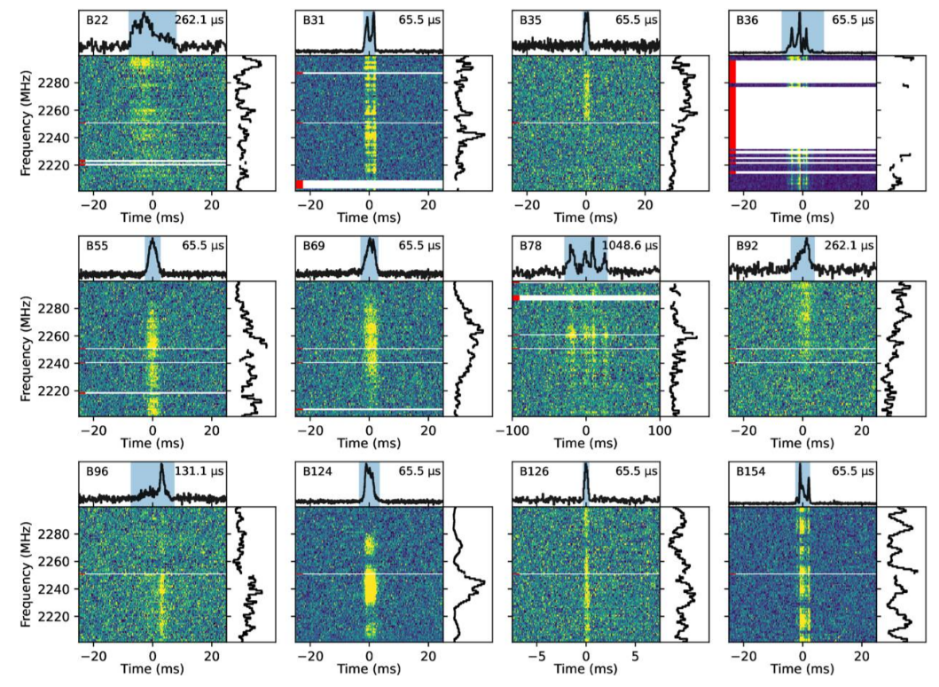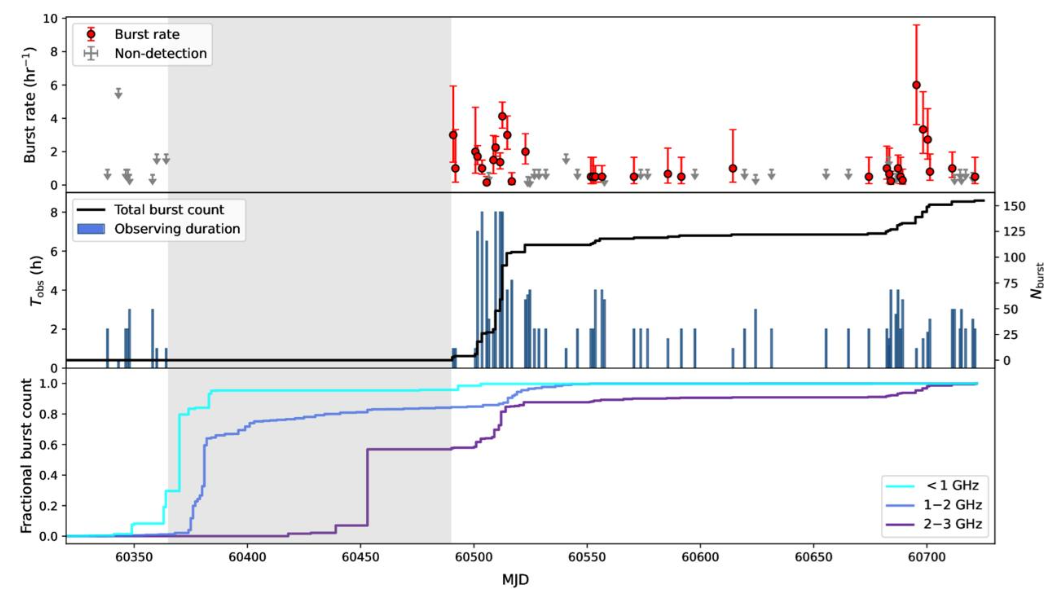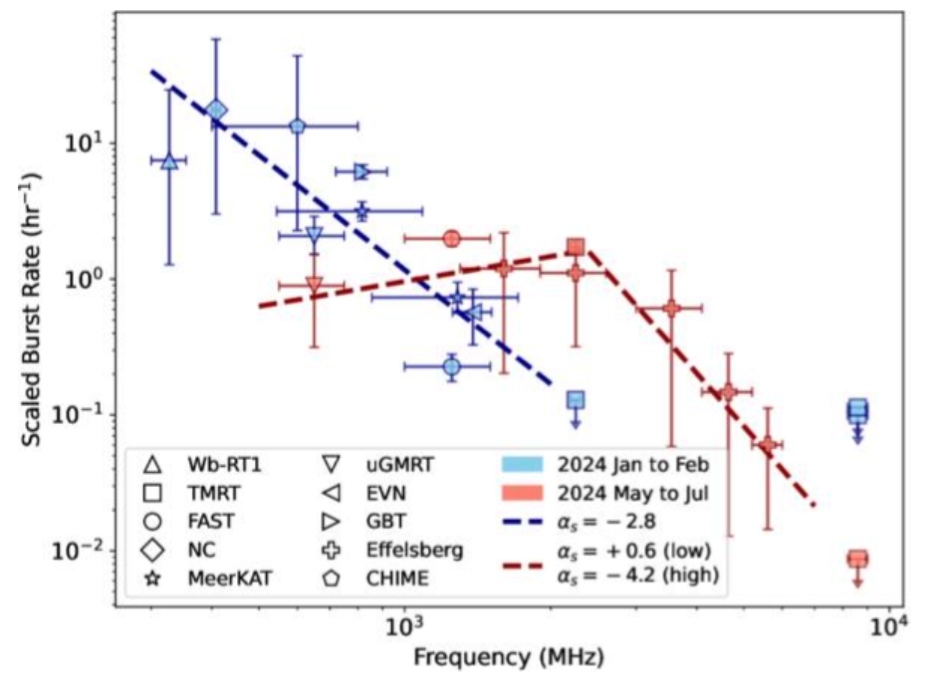New Breakthroughs in High-Frequency Observations of Fast Radio Bursts from Shanghai Tianma Radio Telescope
The Tianma Radio Telescope (TMRT) group of the Shanghai Astronomical Observatory, Chinese Academy of Sciences, conducted 66 simultaneous dual‑frequency (2.25 GHz / 8.60 GHz) observations of the fast radio burst FRB 20240114A over one year, successfully detecting 155 bursts at 2.25 GHz. This effort has established the largest long-term high-frequency (above 2.0 GHz) monitoring database for this target to date.
Fast radio bursts (FRBs) are a class of extremely bright, millisecond‑scale radio “flashes” in the universe. Their origins and radiation mechanisms remain unresolved mysteries in astrophysics. To date, over 4,000 FRBs have been discovered, with the vast majority exhibiting a single burst and only about 100 showing repeated bursts, referred to as repeating fast radio bursts ("repeating FRBs"). FRB 20240114A is a newly discovered repeater identified by the Canadian Hydrogen Intensity Mapping Experiment (CHIME) in January 2024. Its highly active nature has attracted significant attention from research groups worldwide. They have conducted observations using multiple large radio telescopes. Published observation results for this repeating FRB are primarily derived from frequencies at or below 1.4 GHz, with high-frequency bursts (above 2 GHz) being relatively scarce and mostly based on limited observations from the Effelsberg 100-meter Radio Telescope in Germany.
Following the release of the astronomer's telegram announcing the discovery of FRB 20240114A, the TMRT team at Shanghai Astronomical Observatory quickly organized a discussion. Three days later, simultaneous dual‑frequency (2.25 GHz / 8.60 GHz) observations of the burst were formally initiated, leveraging the telescope's unique "one dish, two frequencies" capability. From January 29, 2024, to February 15, 2025, a total of 66 observations were conducted, amounting to approximately 180 hours of cumulative observation time. After a series of careful data reductions, they ultimately confirmed 155 bursts from FRB 20240114A at 2.25 GHz (representative examples shown in Figure 1). By further analysing the evolution of the burst rate over time (see Figure 2), they found that the source was unusually active at 2.25 GHz in July 2024 and early January 2025, with burst rates nearly ten times higher than the average for other observation periods. Although simultaneous observations at 8.60 GHz did not detect corresponding bursts, the team concluded from this result that the activity of FRB 20240114A at that frequency is one to two orders of magnitude lower than at 2.25 GHz. This finding aligns with the narrowband intrinsic radiation properties observed in other repeating FRBs.

Figure 1: Representative bursts of FRB 20240114A detected by TMRT. In each subplot the dynamic spectrum is shown in the centre, with the time‑domain profile above and the frequency‑domain profile on the right.

Figure 2: (Top) Burst rate of FRB 20240114A at 2.25 GHz as a function of time; (middle) Duration of each TMRT observation and the cumulative number of detected bursts; (bottom) Cumulative distribution of burst numbers detected in different frequency intervals for this source, derived by combining results from other telescopes.
The study also found that the “preferred frequency” of FRB 20240114A bursts is not constant. In January–February 2024, its activity decreases as the observing frequency increases; however, in May–July 2024 a pronounced activity peak appears around 2–3 GHz, indicating that the frequency‑dependence of its activity evolves over time. This phenomenon may reflect evolution of the burst’s surrounding environment, such as synchrotron self‑absorption suppressing low‑frequency bursts, or extreme scattering events during signal propagation that modulate the burst rate observed at particular frequencies, among other possibilities.

Figure 3: Burst rate of FRB 20240114A as a function of observing frequency during 2024 January‑February (blue) and May‑July (red). All observations from different telescopes have been scaled to TMRT’s detection threshold, showing a clear change in the frequency‑dependence of the source’s burst rate between the two periods.
This study was conducted in collaboration with researchers from the Shanghai Astronomical Observatory of the Chinese Academy of Sciences, Peking University, Huazhong University of Science and Technology, and Hubei Second Normal University. The work received substantial support from the SKA (Square Kilometer Array) Key Project of the Ministry of Science and Technology, the National Key Research and Development Program, the National Natural Science Foundation of China, and the Shanghai Municipal Natural Science Foundation. The stability of the observation system and the reliability of the data were ensured through the collective efforts of all team members at SHAO. Multi‑frequency observations of FRBs with TMRT are ongoing, and more interesting results will be released in the future, further revealing FRB radiation characteristics and underlying physics from a truly multi‑frequency perspective.
Paper link: https://iopscience.iop.org/article/10.3847/1538-4357/adfece
Scientific contacts:
Zhen YAN, Shanghai Astronomical Observatory, Chinese Academy of Sciences, yanzhen@shao.ac.cn
Zhiqiang SHEN, Shanghai Astronomical Observatory, Chinese Academy of Sciences, zshen@shao.ac.cn
Download attachments: